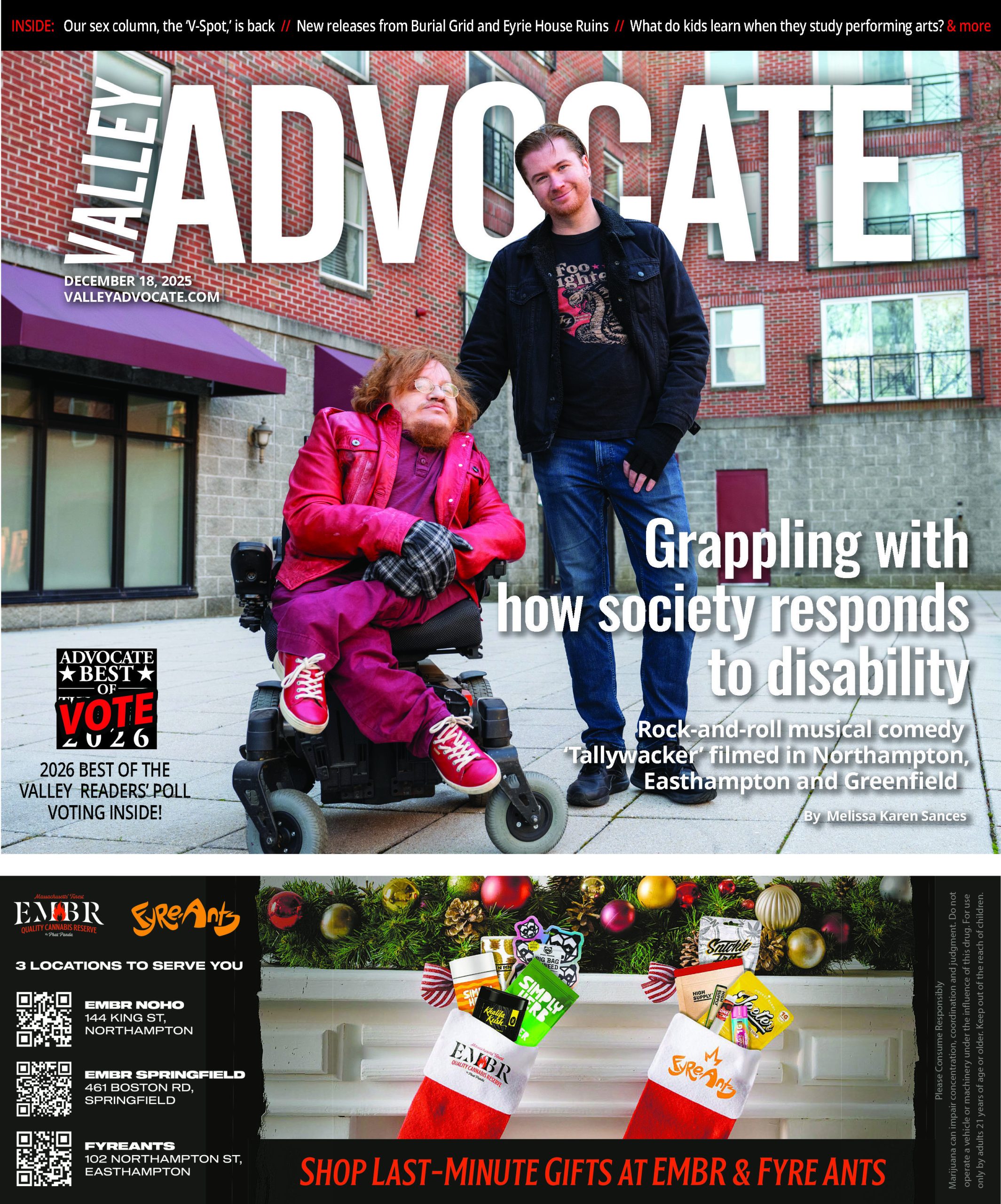Members of the Quabbin Missile Crisis huddle together, skating slowly around the flat track. Each player takes a turn standing taller than the rest, acknowledging the applause from the crowd as Drew Danger announces their names: Jack A. Lope, Chewbecca, Ro$han Roulette, After Risk, Pink Panzer, and so on. After the introductions, the team retreats to the far side of the track and chooses the five skaters who will compete in round one of their bout against the R.I.P. Tides, who are visiting from Portland.
“How many of you are at your very first roller derby?” Drew Danger asks. I raise my hand. So do a handful of others. “Well,” he continues, “I was just like you eight years ago.”
As the blockers and jammers from each team line up, referees move into position, and non-skating officials (scorekeepers and penalty trackers) take their places. The crowd grows eager with anticipation.
Most of the 120 spectators sit in portable beach or camping chairs that they brought with them. The crowd consists of as many men as women. One mom carries her toddler on her back. Another woman takes out her knitting. A few yards in front of her, a spectator with a partially shaved head wears a T-shirt that reads, “Fuck Authority.”
I’m in a warehouse in the Florence section of Northampton, home turf of the Quabbin Missile Crisis and the other teams from Pioneer Valley Roller Derby: Western Mass Destruction, Florence Fightin’ Gals, and The Dirty Dozen. I have come to determine whether roller derby is more sport or subculture. It exhibits qualities of both.
Last year, the Pioneer Valley Roller Derby held two bouts at the Mullins Center on the UMass campus, drawing 600 spectators to their season opener. Other games took place at the Northampton Williston School. But after a season of dwindling crowds and revenues, they began renting the space at the warehouse. Though smaller and less established as a sporting venue, it has one big advantage: it is available 24 hours a day. Like most derby leagues, Pioneer Valley practices several times each week.
The floor is covered by lightweight plastic squares that lock together like a hardwood parquet basketball court. The outer wall is lined with mattresses to protect the players from smacking into the cement. Above the mattresses, the logos of each derby team have been painted on the wall by Bazooka Joe, who started Pioneer Valley Roller Derby with Pink Panzer eight years ago.
—
If you’re front-blocking me, I’m going to fuckin’ destroy you,” Astra Knot told me. “There’s just no way around that.”
She was explaining blocking strategy to me, the Xs and Os of attempting to stop the other team’s jammer while helping your team’s jammer get through the pack. But I was confused, and distracted by the sound of shrieking roller skates coming to a sudden halt a few yards away.
A couple of weeks before the Pioneer Valley Roller Derby bout in Florence, I headed to Wilbraham to watch a scrimmage between members of Pair O’ Dice City Roller Derby and a few players visiting from other leagues—including the CT Roller Girls, who are taking a brief break from their season. As the players divided into two teams, I sat at a booth adjoining the roller rink with Astra Knot and Eve N. Meaner, both of whom had suffered broken ankles from roller derby. Astra Knot broke one ankle. Eve N. Meaner broke both of hers.
“Eve needed a rod to be put in,” co-captain Meryl Creep told me later. “Hers was bad.”
Several Pair O’ Dice members are mothers. Astra Knot and Meryl Creep are both teachers. Eve N. Meaner is one of three librarians on their current roster, but Meryl says they had five or six at one time. Nearly everyone on the team knits.
“There’s no better feeling than a good hit,” Eve N. Meaner told me as we sat rinkside at Interskate. “Even if you are the one getting hit.”
She noted that a lot of women come to derby when faced with a big life transition, after losing a job, struggling with an illness, or moving to a new region. “It’s very empowering,” she adds. “Derby players, they say, have a lot of bumper stickers on their cars.”
As we spoke, the injured players kept watch on the action, yelling out encouragement to teammates, and checking in with those who were momentarily hurt. The team, they tell me, is competitive, but supportive.
Astra Knot adds that a team needs all different body types because of the various skills—blocking, checking, speed skating, endurance skating—involved in derby.
“It’s one of the few times when women are allowed to be aggressive,” Astra Knot says.
—
The Texas Rollergirls are credited with reviving flat track roller derby in Austin, Texas in the early part of this century. For much of the 20th century, roller derby took place on a raised track. In the 1930s, a man named Leo Seltzer started a touring competition called Trancontinental Roller Derby. Early television broadcasts showed the competitions a decade later, and popularity grew. By the time Seltzer transferred his business to his son Jerry in the 1960s, competing roller derby franchises began emerging, many of them emphasizing theatrics over sport. Jerry Seltzer shut down his organization in 1973.
Several players used to skate under the same name, Astra Knot and Eve N. Meaner told me, which was given to them by a manager or organizer. Roller derby was more like professional wrestling or a game by the Harlem Globetrotters, with story lines involving various characters, and predetermined results.
As it has evolved, the sport has seen the development of a complicated bureaucracy.
Today, both women’s and men’s roller derby are governed by their own separate international organizations—the Women’s Flat Track Derby Association (WFTDA) and the Men’s Roller Derby Association (MRDA). The men’s association was founded in 2007, and today includes 47 leagues in North America and Europe. The women’s association was founded in 2005, and today represents 259 official leagues in Asia, Australia, Europe, South, and North America, as well as 98 more apprentice leagues worldwide.
Many other leagues, like Pair O’ Dice Roller Derby and Elm City Derby Damez—who play in Brattleboro but are based in Keene—are not affiliated with either organization.
—
When it began in 2006, Bazooka Joe tells me, Pioneer Valley Roller Derby was the only men’s derby in the entire world. They endured a lot of criticism, and even received hate mail.
“The main idea of the opposition was that we were going to ruin roller derby by allowing men to play,” he says. “Some women didn’t like the idea of men playing a sport they created—despite the fact that before the flat track era, roller derby was notable for being the only sport that was co-ed since its inception.”
“We got a few emails or posts on online roller derby forums,” continues Bazooka Joe. “They were mostly anonymous or from people far away who didn’t need to worry about saying nasty things to people they might run into at a game. We ignored it and tried to make ourselves known in the New England derby scene as friendly and helpful. We went to every other club’s games and volunteered to help with all manner of production duties.”
A co-ed league, Pioneer Valley Roller Derby is part of the Men’s Roller Derby Association, but not the Women’s Flat Track Derby Association.
“We have far more women than men in PVRD,” says Bazooka Joe. “Our women aren’t allowed in WFTDA because our organization has men in it. Current WFTDA rules do not allow organizations that have any male players in them.”
Though “that appears to be on the verge of changing,” he adds.
“We recently signed a cooperative agreement with the Men’s Roller Derby Association,” Kali Schumitz, public relations manager for the Women’s Flat Track Derby Association tells me. “As part of that agreement, we have committed to examining membership options for leagues that have women’s and men’s teams as part of the same business structure.”
“Many of our member leagues have strong relationships and even share resources with men’s teams in their respective cities,” Schumitz says of the WFTDA’s current bylaws, “but the teams exist as separate legal entities.”
—
To a derby outsider, attempting to sort through the various teams and leagues and associations can be as challenging as understanding how the game is played and scored. But as I try to wrap my mind around the intricate world of roller derby, it seems poised to evolve yet again.
“Since I started three or four years ago, it has changed in many ways,” says Meryl Creep. “It has become more fan-friendly and easier for people watching to follow, it has streamlined penalties, and as the athletes improve, the way it is played develops too. I see it making its way to the Olympics in the near future. There are teams all over the world and just as many junior teams. Those kids are going to be amazing skaters.”
(Roller sports were considered for the 2020 Olympic games, but did not make the final cut.)
“Derby is struggling to find its identity as a sport,” Astra Knot says. “We want to be taken seriously as athletes, but we still want to have a lot of fun and keep to the funkier roots of the game.”
Those roots were easily recognizable at the Quabbin Missile Crisis vs. R.I.P. Tides bout I attended in Florence: the punny, playful derby names, the team uniforms, adorned with knee-high socks, leggings, and so forth. (Many players I spoke with mentioned making the journey to derby super store Bruised Boutique in Nashua to get gear.)
Some players, like Meryl Creep, grew up playing a variety of sports, and enjoy the team comaraderie and competition. Others are drawn to derby for reasons less clear.
When Bazooka Joe and Pink Panzer started Pioneer Valley Roller Derby eight years ago, neither of them knew how to skate, let alone play derby. But after hearing of a friend’s experience in Providence, they were hooked.
Watching Pink Panzer run a practice as I talk to Bazooka Joe, I’m struck by the multiple roles he and Panzer play: founders, general managers, coaches.
Pink Panzer played some soccer growing up, Bazooka Joe tells me, but he didn’t play organized sports. “I just love derby,” he says.
Pioneer Valley Roller Derby is now in a transition period, switching from a Limited Liability Company owned by Bazooka Joe and Pink Panzer to a non-profit run by a board of directors. It’s a transition Joe says he is happy about, even as he admits he’s concerned whether a new leadership structure will translate to a stable future for their derby league.
Whatever its future, it seems certain that roller derby—both here in the Valley and in its many leagues worldwide—will retain its devoted following of players.
“Derby is addictive,” says Eve N. Meaner. “Nothing compares to it. Other people will talk about what they do and I’ll think, ‘Yeah, but it’s not derby.’”


